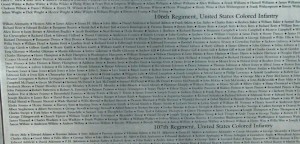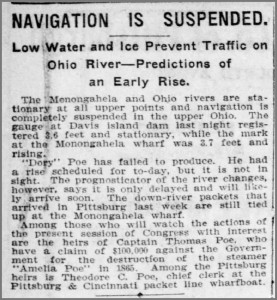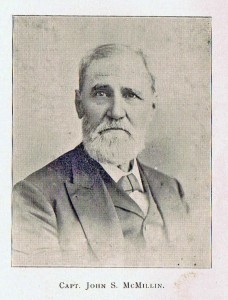
African American Civil War Monument (F Nash Collection 2015)
Andrew Poe, the son of Rev Adam Poe (co-founder of Ohio Wesleyan College), earned the rank of Captain in the Civil War. Andrew first enlisted at age 35 as a private with Co A of the 63rd Ohio Volunteer Infantry on 25 Jan 1862. He was commissioned Captain of Company C in the 106th Regiment, US Colored Infantry from 16 May 1864 till 14 Nov 1864. Then he was transferred to Company C of the 40th Regiment, US Colored Infantry. The 40th and 106th Regiments were consolidated on 7 Nov 1864. [1] He was mustered out on 25 Apr 1865.[2] The dates seem a bit off. Some time at the African American Civil War Museum will untangle the dates.
Andrew Poe is listed on the memorial wall of the African American Civil War Memorial and Museum in Washington, DC. Andrew’s name is engraved on Wall C plaque 55 and plaque 103. The 40th US Colored Infantry troops are honored on plaque 55; the 106th on plaque 103. The museum website link follows:
http://afroamcivilwar.org/home.html

Andrew Poe, 106th Regiment USCT ( F Nash Collection 2015)
After the war in a letter to General Clinton B Fisk of the Freedmen’s Bureau, Andrew wrote about a battle where he fought with his men until only seven of them survived. The site of the battle has not yet been determined.
“I fought until only seven of my men stood living beside me. The graves of my poor men and of our enemies are witnesses that I tried to do a soldiers duty. Long as I could be with the men whom I had personally rescued from Slavery and whose perils and imprisonment I had shared, I preferred my Company . . .”

Andrew Poe 40th Regiment USCT (F Nash Collection 2015)
Rev Adam Poe’s brother, Daniel had a son named Andrew A Poe. (Daniel was a Methodist Episcopal missionary in Texas who died the same day as his wife in Matagorda, TX. The cause of their deaths is not known.) Andrew A enlisted with Company D, Ohio 1st LA Batty( Light Artillery Battery) on 15 Aug 1862. He was promoted to full Corporal on 15 Jun 1864. He was killed at Kennesaw Mountain and was buried at Marietta National Cemetery.
Rev Adam Poe’s brother Charles, not a minister, was the father of Gen Orlando Metcalf Poe. Orlando served as a Colonel under Gen Sherman on the march to Savannah. As Sherman’s chief engineer he orchestrated the burning of Atlanta, for which action he was honored by Sherman and hated by the entire confederacy.
Rev Adam Poe’s son and two nephews have quite a record. They were Union men. Their loyalties were deeply felt. They were fearless soldiers much like their great grandfather Adam and his brother Andrew who were famed for their Revolutionary War service and their frontier battles with the Indians along the Ohio River in southern Beaver County, PA. The Revolutionary War militiaman, Andrew, engaged the Wyandot Indian Chief Bigfoot in hand to hand combat in arguably the most famous bit of history of the Ohio frontier.
Rev Adam Poe’s son and two nephews were first cousins once removed from the steamboat captains of Georgetown, PA: Andrew, Jacob, Adam W, Thomas W, and George W. I often wonder whether paths crossed. Could my Georgetown steamboat captains have transported their OH cousins to their Union duty stations in the western theater? Think about that for a few moments.
63rd Regiment, Ohio Infantry
Overview:
Organized at Marietta, Ohio, by consolidation of Battalions of the 22nd and 63rd Ohio Infantry January 25, 1862. Moved to Paducah, Ky., February 18-23, thence to Commerce, Mo. Attached to 2nd Brigade, 1st Division, Army of the Mississippi, to April, 1862, 1st Brigade, 2nd Division, Army of the Mississippi, to November, 1862. 1st Brigade, 8th Division, Left Wing 13th Army Corps (Old), Dept. of the Tennessee, to December, 1862. 1st Brigade, 8th Division, 16th Army of the Tennessee, to March, 1863. 4th Brigade, District of Corinth, Miss., 2nd Division, 16th Army Corps, to May, 1863. 3rd Brigade, District of Memphis, 5th Division, 16th Army Corps, to November, 1863. Fuller’s Brigade, 2nd Division, 16th Army Corps, to March, 1864. 2nd Brigade, 4th Division, 16th Army Corps, to September, 1864. 2nd Brigade, 1st Division, 17th Army Corps, to July, 1865.
Service:
Operations against New Madrid, Mo., March 3-14, 1862. Siege and capture of Island Number 10, Mississippi River, and pursuit to Tiptonville, March 15-April 8. Tiptonville April 8. Expedition to Fort Pillow, Tenn., April 13-17. Moved to Hamburg Landing, Tenn., April 18-23. Action at Monterey April 29. Advance on and siege of Corinth, Miss., April 29-May 30. Skirmish at Farmington May 1. Reconnoissance toward Corinth May 8. Occupation of Corinth May 30, and pursuit to Booneville May 30-June 12. Duty at Clear Creek till August 29. Battle of Iuka, Miss., September 19. Reconnoissance from Rienzi to Hatchie River September 30. Battle of Corinth October 3-4. Pursuit to Ripley October 6-12. Grant’s Central Mississippi Campaign, operations on the Mississippi Central Railroad November 2, 1862, to January 12, 1863. Expedition to Jackson after Forest December 18, 1862, to January 3, 1863. Action at Parker’s Cross Roads December 30, 1862. Red Mound, or Parker’s Cross Roads, December 31. Lexington, Tenn., January 3, 1863. Moved to Corinth, Miss., January 9, and duty there till April. Dodge’s Expedition into Northern Alabama April 15-May 8. Rock Cut, near Tuscumbia, April 22. Tuscumbia April 23. Town Creek April 28. Duty at Memphis, Tenn., till October 18. Movement to Prospect, Tenn., October 18 November 30, and duty there till January, 1864. Veterans absent on Furlough January 2 to February 28, 1864. Decatur, Ala., March 8. Duty at Decatur till May. Atlanta Campaign May 1-September 8. Demonstrations on Resaca May 8-13. Sugar Valley near Resaca May 9. Battle of Resaca May 14-15. Advance on Dallas May 18-25. Operations on line of Pumpkin Vine Creek and battles about Dallas, New Hope Church and Allatoona Hills May 25-June 5. Operations about Marietta and against Kenesaw Mountain June 10-July 2. Assault on Kenesaw June 27. Nickajack Creek July 2-5. Ruff’s Mills July 3-4. Chattahoochie River July 5-17. Decatur and Battle of Atlanta July 22. Siege of Atlanta July 22-August 25. Ezra Chapel July 28. Flank movement on Jonesboro August 25-30. Battle of Jonesboro August 31-September 1. Lovejoy Station September 2-6. At East Point till October 4. Pursuit of Hood into Alabama October 4-26. March to the sea November 15-December 10. Montieth Swamp December 9. Siege of Savannah December 10-21. Campaign of the Carolinas January to April, 1865. Reconnoissance to the Salkehatchie River, S. C., January 20. Salkehatchie Swamps February 2-5. Skirmishes at Rivers and Broxton Bridges February 2. Action at Rivers Bridge February 3. Binnaker’s Bridge, South Edisto River, February 9. Orangeburg February 12-13. Columbia February 16-17. Battle of Bentonville, N. C., March 20-21. Occupation of Goldsboro March 24. Advance on Raleigh April 10-14. Occupation of Raleigh April 14. Bennett’s House April 26. Surrender of Johnston and his army. March to Washington, D. C., via Richmond, Va., April 29-May 20. Grand Review May 24. Moved to Louisville, Ky., June 5, and duty there till July. Mustered out July 8, 1865.
Regiment lost during service 2 Officers and 91 Enlisted men killed and mortally wounded and 5 Officers and 259 Enlisted men by disease. Total 357. [3]
40th United States Colored Infantry
The 40th United States Colored Infantry was organized at Nashville, Tennessee, in February
1864. The 40th USCI spent its entire service guarding railroad lines and depots in
Tennessee. Its primary responsibilities were guard duty along the Nashville and Louisville
Railroad, the Northwestern Railroad, and railroad depots in the District of East Tennessee.
The regiment fought a skirmish at South Tunnel, near Gallatin, on October 10, 1864. The
40th USCI mustered out of service on April 25, 1866.[4]
106th Regiment Infantry
Organized May 16, 1864, from 4th Alabama Colored Infantry. Attached to District of North Alabama, Dept. of the Cumberland, to February, 1865. Defenses of Nashville & Northwestern Railroad, Dept. of the Cumberland, to November, 1865.
SERVICE.–Garrison at Pulaski and railroad guard duty entire term. Forest’s attack on Athens, Ala., September 23-24, 1864. Consolidated with 40th United States Colored Troops November 7, 1865.[5]
References.
[1] http://www.bgsu.edu/colleges/library/cac/cwar/063ovib.html
[2] http://www.bgsu.edu/colleges/library/cac/cwar/063ovib.html
[3] http://www.nps.gov/civilwar/search-regiments-detail.htm?regiment_id=UOH0063RI
4 http://www.archives.gov/research/microfilm/m1993.pdf






